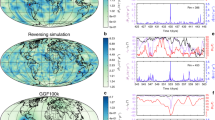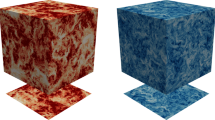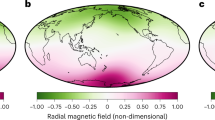Abstract
The ‘geodynamo’ in the Earth's liquid outer core produces a magnetic field that dominates the large and medium length scales of the magnetic field observed at the Earth's surface1,2. Here we use data from the currently operating Danish Oersted3 satellite, and from the US Magsat2 satellite that operated in 1979/80, to identify and interpret variations in the magnetic field over the past 20 years, down to length scales previously inaccessible. Projected down to the surface of the Earth's core, we found these variations to be small below the Pacific Ocean, and large at polar latitudes and in a region centred below southern Africa. The flow pattern at the surface of the core that we calculate to account for these changes is characterized by a westward flow concentrated in retrograde polar vortices and an asymmetric ring where prograde vortices are correlated with highs (and retrograde vortices with lows) in the historical (400-year average) magnetic field4,5. This pattern is analogous to those seen in a large class of numerical dynamo simulations6, except for its longitudinal asymmetry. If this asymmetric state was reached often in the past, it might account for several persistent patterns observed in the palaeomagnetic field7,8,9,10. We postulate that it might also be a state in which the geodynamo operates before reversing.
This is a preview of subscription content, access via your institution
Access options
Subscribe to this journal
Receive 51 print issues and online access
$199.00 per year
only $3.90 per issue
Buy this article
- Purchase on Springer Link
- Instant access to full article PDF
Prices may be subject to local taxes which are calculated during checkout



Similar content being viewed by others
References
Merrill, R. T., McElhinny, M. W. & McFadden, P. L. The Magnetic Field of the Earth, Paleomagnetism, the Core and the Deep Mantle (Academic, San Diego, 1996).
Langel, R. A. & Hinze, W. J. The Magnetic Field of the Earth's Lithosphere, The Satellite Perspective (Cambridge Univ. Press, Cambridge, 1998).
Neubert, T. et al. Oersted satellite captures high-precision geomagnetic field data. Eos 82, 81, 87–88 (2001).
Bloxham, J., Gubbins, D. & Jackson, A. Geomagnetic secular variation. Phil. Trans. R. Soc. Lond. A 329, 415–502 (1989).
Jackson, A., Jonkers, A. R. T. & Walker, M. R. Four centuries of geomagnetic secular variation from historical records. Phil. Trans. R. Soc. Lond. A 358, 957–990 (2000).
Olson, P., Christensen U. & Glatzmaier, G. Numerical modeling of the geodynamo: Mechanisms of field generation and equilibration. J. Geophys. Res. 104, 10383–10404 (1999).
Hulot, G. & Gallet, Y. On the interpretation of virtual geomagnetic pole (VGP) scatter curves. Phys. Earth. Planet. Inter. 95, 37–53 (1996).
Gubbins, D. & Kelly, P. Persistent pattern in the geomagnetic field over the past 2.5 Myr. Nature 365, 829–832 (1993).
Gubbins, D. & Coe, R. Longitudinally confined geomagnetic reversal paths from non-dipole transition fields. Nature 362, 51–53 (1993).
Constable, C. Link between geomagnetic reversal paths and secular variation of the field over the past 5 Myr. Nature 358, 230–233 (1992).
Langlais, B., Mandea, M. & Ultré-Guérard, P. High-resolution magnetic field modelling: application to MAGSAT and Oersted data. Phys. Earth. Planet. Inter. (in the press).
Purucker, M., Langlais, B., Olsen, N., Hulot, G. & Mandea, M. The southern edge of cratonic North America: Evidence from new satellite magnetometer observations. Geophys. Res. Lett. (in the press).
Olsen, N. Induction studies with satellite data. Surv. Geophys. 20, 309–340 (1999).
Tarits, P. & Naphsica, G. Electromagnetic induction effects by the solar quiet magnetic field at satellite altitude. Geophys. Res. Lett. 27, 4009–4012 (2000).
Roberts, P. H. & Scott, S. On the analysis of the secular variation. 1. A hydromagnetic constraint: Theory. J. Geomagn. Geoelectr. 17, 137–151 (1965).
Bloxham, J. & Jackson, A. Fluid flow near the surface of Earth's outer core. Rev. Geophys. 29, 97–120 (1991).
Hulot, G., Le Mouël, J. L. & Wahr, J. Taking into account truncation problems and geomagnetic model accuracy in assessing computed flows at the core-mantle boundary. Geophys. J. Int. 108, 224–246 (1992).
Le Mouël, J. L. Outer core geostrophic flow and secular variation of Earth's magnetic field. Nature 311, 734–735 (1984).
Jault, D., Gire, C. & Le Mouël, J. L. Westward drift, core motions and exchanges of angular momentum between core and mantle. Nature 333, 353–356 (1988).
Jackson, A., Bloxham, J. & Gubbins, D. in Dynamics of Earth's Deep Interior and Earth Rotation (eds Le Mouël, J.-L. et al.) 97–107 (IUGG Vol. 12, AGU Geophysical Monograph 72, American Geophysical Union, Washington DC, 1993).
Pais, A. & Hulot, G. Length of day decade variations, torsional oscillations and inner core superrotation: evidence from recovered core surface zonal flows. Phys. Earth. Planet. Inter. 118, 291–316 (2000).
Zatman, S. & Bloxham, J. Torsional oscillations and the magnetic field within the Earth's core. Nature 388, 760–763 (1997).
Olson, P. & Aurnou, J. A polar vortex in the Earth's core. Nature 402, 170–173 (1999).
Glatzmaier, G. & Roberts, P. A three-dimensional convective dynamo solution with rotating and finitely conducting inner core and mantle. Phys. Earth. Planet. Inter. 91, 63–75 (1995).
Kuang, W. & Bloxham, J. in The Core-Mantle Boundary Region (eds Gurnis, M. et al.) 187–208 (Geodyn. Ser. 28, American Geophysical Union, Washington DC, 1998).
Rau, S., Christensen, U., Jackson, A. & Wicht, J. Core flow inversion tested with numerical dynamo models. Geophys. J. Int. 141, 485–497 (2000).
Dormy, E., Valet, J. P. & Courtillot, V. Numerical models of the geodynamo and observational constraints. Geochem. Geophys. Geosyst. 1, 62 (2000).
Gubbins, D. & Bloxham, J. Morphology of the geomagnetic field and implications for the geodynamo. Nature 325, 509–511 (1987).
Constable, C. G., Johnson, C. L. & Lund, S. P. Global geomagnetic field models for the past 3000 years: transient or permanent flux lobes? Phil. Trans. R. Soc. Lond. A 358, 991–1008 (2000).
Carlut, J. & Courtillot, V. How complex is the Earth's average magnetic field? Geophys. J. Int. 134, 527–544 (1998).
Acknowledgements
We thank those involved in the Oersted project for their contribution to this work. The Oersted project is funded by the Danish Ministry of Transport, the Ministry of Research and Information Technology, and the Ministry of Trade and Industry of Denmark. Additional support for Oersted came from NASA, the Centre National d’Etudes Spatiales (CNES) and DARA. We also thank R. Holme for comments and suggestions.
Author information
Authors and Affiliations
Corresponding author
Ethics declarations
Competing interests
The authors declare that they have no competing financial interests
Rights and permissions
About this article
Cite this article
Hulot, G., Eymin, C., Langlais, B. et al. Small-scale structure of the geodynamo inferred from Oersted and Magsat satellite data. Nature 416, 620–623 (2002). https://doi.org/10.1038/416620a
Received:
Accepted:
Issue Date:
DOI: https://doi.org/10.1038/416620a
This article is cited by
-
Possible molecular and cellular mechanisms at the basis of atmospheric electromagnetic field bioeffects
International Journal of Biometeorology (2021)
-
Investigation of regional variation in core flow models using spherical Slepian functions
Earth, Planets and Space (2019)
-
A reappraisal of instrumental magnetic measurements made in Western Europe before AD 1750: confronting historical geomagnetism and archeomagnetism
Earth, Planets and Space (2017)
Comments
By submitting a comment you agree to abide by our Terms and Community Guidelines. If you find something abusive or that does not comply with our terms or guidelines please flag it as inappropriate.



